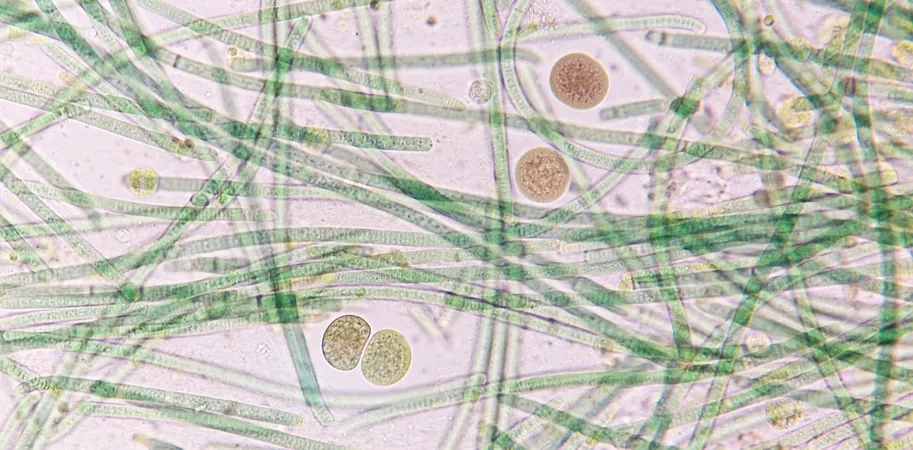
Unlocking the Secrets of Life: AI Traces 3 Billion Years of Bacterial Evolution
2025-04-03
Author: Ming
Unlocking the Secrets of Life: AI Traces 3 Billion Years of Bacterial Evolution
Scientists estimate there are around a trillion species of microorganisms on Earth, with the overwhelming majority being bacteria. These fascinating organisms, composed of a single cell and devoid of bones, present a challenge for paleontologists seeking to trace their evolutionary lineage due to their lack of distinct fossil records.
Recent research harnessing the power of artificial intelligence (AI) has provided new insights into the evolutionary history of bacteria. In a groundbreaking study published in the prestigious journal Science, researchers discovered that certain bacteria developed the ability to utilize oxygen long before Earth’s atmosphere became saturated with it—approximately 2.4 billion years ago.
An Earth-Shattering Event
The timeline of Earth is punctuated by monumental events, particularly the violent formation of the Moon about 4.5 billion years ago, caused by a colossal collision with a Mars-sized body. This cataclysm may have obliterated any pre-existing life. Following this, the ancestors of all living beings emerged: single-celled microbes. For the first 80% of Earth’s history, these microorganisms dominated the planet.
The renowned evolutionary biologist Theodosius Dobzhansky famously stated, “Nothing in biology makes sense except in the light of evolution,” prompting scientists to explore how life evolved throughout Earth’s early history.
Deciphering the Tree of Life
By analyzing the diverse DNA sequences of existing life forms, scientists have been able to infer relationships among different groups, revealing surprising connections—humans share a closer genetic bond with mushrooms than with apple trees. However, while DNA comparisons illuminate relationships, they do not specify the timing of evolutionary events.
Geological evidence highlights the Great Oxidation Event, a pivotal transitional period about 2.4 billion years ago that transformed Earth's atmosphere through the action of cyanobacteria. These microorganisms innovated photosynthesis, using sunlight to convert carbon dioxide into energy while inadvertently producing oxygen—a poison for many early bacteria, leading to a mass extinction event. Survivors either adapted to utilize oxygen or sought refuge in anaerobic environments.
Reconstructing Bacterial Evolution with AI
The significance of the Great Oxidation Event lies not just in its historical impact but in its precise dating, which enabled researchers to calibrate a timeline of bacterial evolution. By training AI models to identify whether a bacterium thrives in the presence of oxygen based on its genetic makeup, scientists were able to apply modern machine learning techniques to predict past bacterial behaviors.
The study’s results yielded an astonishing revelation: some lineages of bacteria capable of using oxygen existed as much as 900 million years prior to the Great Oxidation Event, indicating that these microorganisms had evolved to handle oxygen, even in its absence.
Perhaps most surprising is the finding that cyanobacteria, known for their role in producing oxygen, had developed the ability to utilize oxygen before they even mastered photosynthesis.
A New Understanding of Evolution
This innovative research combines geological, paleontological, phylogenetic, and machine learning methodologies to refine our understanding of bacterial evolution, illustrating how life's capabilities have evolved in tandem with Earth’s climatic shifts. These findings not only reshape our grasp of bacterial history but also hint at the incredible adaptability of life, suggesting that even amid scarcity, evolution beats on, waiting for the right moment to flourish.
This groundbreaking work sets the stage for future explorations into the intricate relationships and histories of life on Earth, challenging our perceptions of how we understand evolutionary biology in the grand tapestry of life. Stay tuned as this research continues to unfold; the journey through Earth's early microbial life is only just beginning!




 Brasil (PT)
Brasil (PT)
 Canada (EN)
Canada (EN)
 Chile (ES)
Chile (ES)
 Česko (CS)
Česko (CS)
 대한민국 (KO)
대한민국 (KO)
 España (ES)
España (ES)
 France (FR)
France (FR)
 Hong Kong (EN)
Hong Kong (EN)
 Italia (IT)
Italia (IT)
 日本 (JA)
日本 (JA)
 Magyarország (HU)
Magyarország (HU)
 Norge (NO)
Norge (NO)
 Polska (PL)
Polska (PL)
 Schweiz (DE)
Schweiz (DE)
 Singapore (EN)
Singapore (EN)
 Sverige (SV)
Sverige (SV)
 Suomi (FI)
Suomi (FI)
 Türkiye (TR)
Türkiye (TR)
 الإمارات العربية المتحدة (AR)
الإمارات العربية المتحدة (AR)